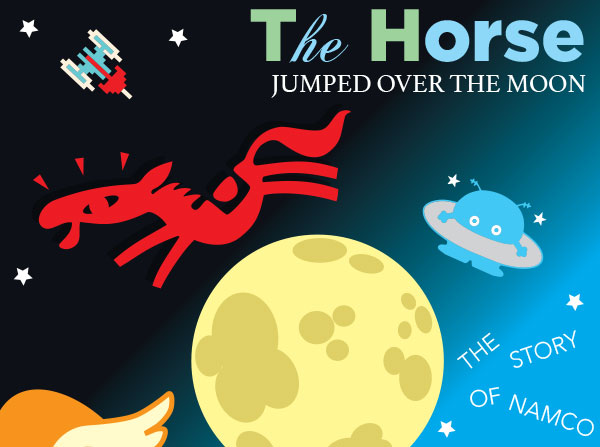
This new series was actually the part of multiple things coming together at the same time. At the end of 2023, and the start of 2024 I convinced my wife to start recording a new podcast series. A lifetime ago she taught a college class on the history of theme parks, she called it “Manufacturing the Magic.” I posted the links on this blog at the start of 2025. We will continue those episodes intermittently on her Pink Monorail Podcast. When she originally taught the class it was everything that lead up in world history to the creation of Disneyland.
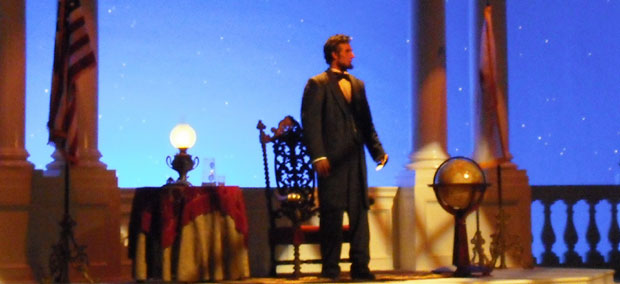
I convinced her to redo her notes, and even put together slideshows for any instructors that wanted to teach the class as well. She said that it would be roughly 10 lessons from pre-history leading up to Disneyland. Then she had nothing after planned. Since she was an exceptional researcher, and storyteller I convinced her to continue the series, and talk about how theme parks evolved from 1955 to today, as all new lessons. She obliged, and we started recording in February 2024. We agreed that there was an important chapter that had to be added during the late ‘70s through the ‘90s with the rise of video games. I offered to record those episodes of the series. We would trade roles, I’d be the teacher, and she would be the student sitting in as the cohost. The entire reason why this fit into the episodes was because the Themed Entertainment Association (TEA) in 2012 had a keynote speech in where they lamented that an entire generation of potential theme park creators were instead developing video games.
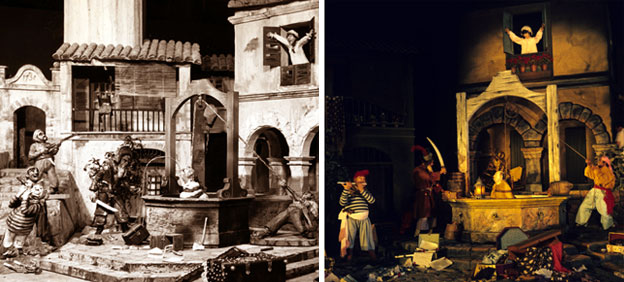
I had to explain why Gen-X wanted to work on a new form of entertainment, instead of at the biggest theme parks, and amusement parks in the world. In doing research I put together the links that connected one of the oldest game companies, and the first, and only video game theme park in history. This fortuitous coincident happened as I was going to write about Namco anyway. The studio had an aesthetic in some of their games that I wanted to highlight, but would also make a fun blog to put together. The details for this blog were pulled from Wikipedia, journalist Kazuhisa Maeno, and Namco Graffiti magazine. I encourage you to support Wikipedia with a donation. I do so every year for how much they help me get dates, and names right for blogs.
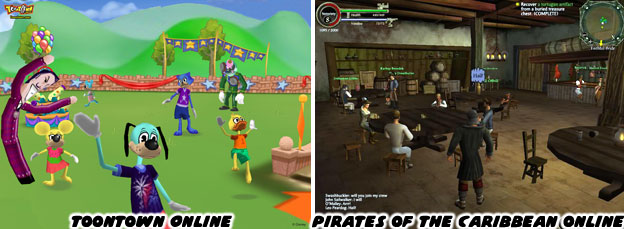
In order to tell the story of the first video game theme park, we had to go way back in time to the foundation of Namco (now Bandai Namco Entertainment) . When you thought about the company what came to mind? Was it Pac-Man, Tekken, Galaga, Dragon Ball, Ridge Racer, Dark Souls, or any of a thousand other games? Maybe it was appreciating the entire genres that they pioneered? Did you have a favorite Namco title, or character? Would you believe that they were making waves in amusement for decades before video games came around? The story of the company, and its founder were very unique. Masaya Nakamura was born in Tokyo December 24, 1925. He graduated from the Yokohama Institute of Technology in 1948, having earned a degree in shipbuilding. He worked for his father, and sold air guns for a few years, then went on to found his own company in 1955; Nakamura Seisakusho, Ltd., which produced pop-cork guns, electromechanical (he would call them elemecha for short), and coin-operated mechanical rides for Japanese department store rooftops. That same year Disneyland was founded. His and Disney's paths would cross in the future.
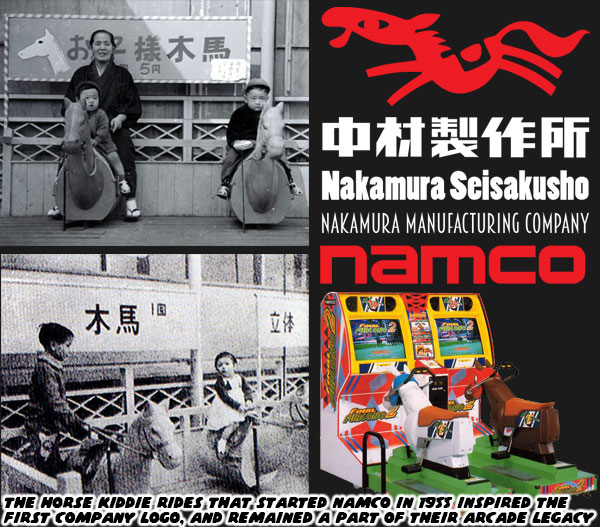
There were only three employees at the start, including Mr. Nakamura. Their first sale were two wooden horse kiddie rides with serial numbers N10001 and N10007. The iron legs of the horses could be moved up and down by turning a crank much like the merry-go-round horses in traditional amusement parks. The rocking horses inspired the creation of their original logo, a cartoonish race horse, whose saddle also was reminiscent of the Japanese flag. These rides were installed on the rooftop of the then Matsuya Department Store in Isezakicho, Yokohama City. Soon after they won a contract to build a small amusement park on the roof of Mitsukoshi Department Store in downtown Tokyo's Nihombashi shopping district. Mitsukoshi was the biggest department store chain in Japan, and its branch stores all over the country started turning their rooftops into playgrounds. Nakamura got the contract at all of these locations. In less than a decade his company had become Japan's leading amusement park operator.
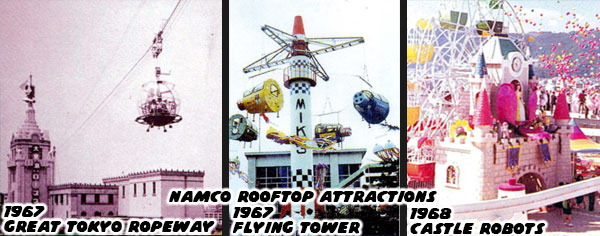
That wasn’t the only big break that the young company had. In 1956 Periscope was published by Sega, but manufactured by Nakamura Seisakusho Co., Ltd. It was one of the most successful elemecha games of all time. You could still find some cabinets in operation to this day. This helped a young Sega, and Namco get a foothold in arcades. In 1959 Walt Disney Productions provided Nakamura with the resources to expand his operations. This relationship also turned to officially licensed rides which they would put in their amusement centers. Nakamura, and his designers were heavily influenced by the audio animatronics they had seen in Disneyland, and would create their own androids as well. Namco would also build kiddie rides featuring Godzilla, and other high-profile IP in their various arcades, and game centers.
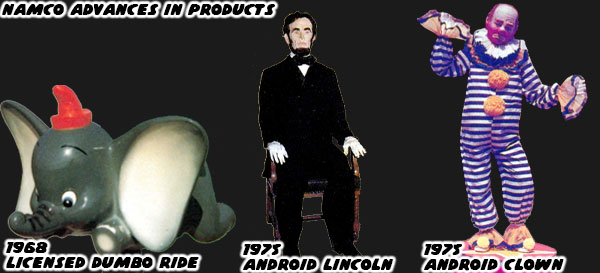
Thanks to PONG (1972), and later Space Invaders (1977) studios around the world saw that video games were the wave of the future. Namco got the rights to distribute Atari games in Japan in the early 70’s. In 1974 they bought the Japanese division of Atari from Nolan Bushnell, and formed the Nakamura Manufacturing Company, this would give them the head start on video game production before many other publishers. In 1977 they changed their name to NAMCO. In 1978 they debuted Galaxian. It was their answer to the Space Invader craze. Namco’s first shoot ‘em up game innovated on the space shooter genre including being one of the first to feature score bonuses, and have an RGB monitor. The board would also be used in future games including King & Balloon which was the first arcade game to incorporate speech. When the king was kidnapped he would yell “help”, and “thank you” when he was rescued. Galaxian would be the cornerstone
that the entire UGSF universe had been built on.

Being in the amusement industry allowed the company to grow steadily through the ‘70s, and ‘80s. They lacked the capital to buy out Atari in Japan as no bank would loan them the money, but Mr. Nakamura was able to secure smaller loans, and pay off Bushnell in a few years. Rooftop attractions allowed Namco to become synonymous with family entertainment. The company would not only operate the majority of rooftop attractions in the densely packed Japanese cities, but they would begin developing several different types of arcades, in malls, as stand-alone storefronts, and even massive gaming centers. Each one had its own sort of theme, and branding.
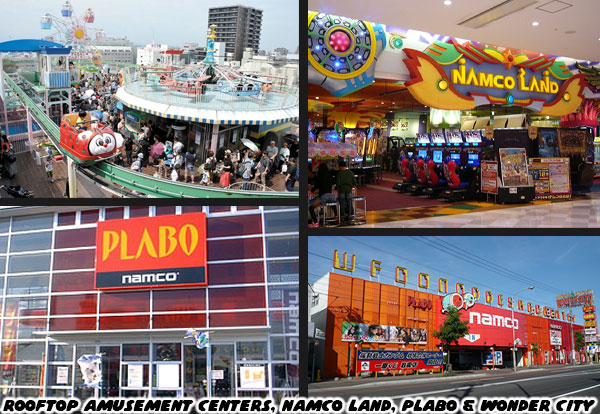
Generation-X in Japan would have fond memories of the Namco brand. Chances were the first kiddie rides, carousels, trains, and monorails they rode were by Namco. The first carnival-type games, including whack-a-mole were probably built by Namco. Their earliest video game memories were also associated with Namco. The company was aware of this, and their arcade experience evolved with the tastes, and age of their fans. In the early ‘90s the company was opening game centers, that folded in shopping, and restaurants. The company even opened up pool halls, and medallion centers (similar to casinos, without breaking the strict gambling laws in Japan). These were places for college-age people to visit, or when dating, or even recently married young couples. These locations mirrored the growth of Dave & Busters (founded in 1982), and predated the rise of GameWorks (founded in 1996) in the USA. In 2015 Namco announced that
they would be opening arcades with the Hooters brand, again demonstrating that they were evolving with the times.
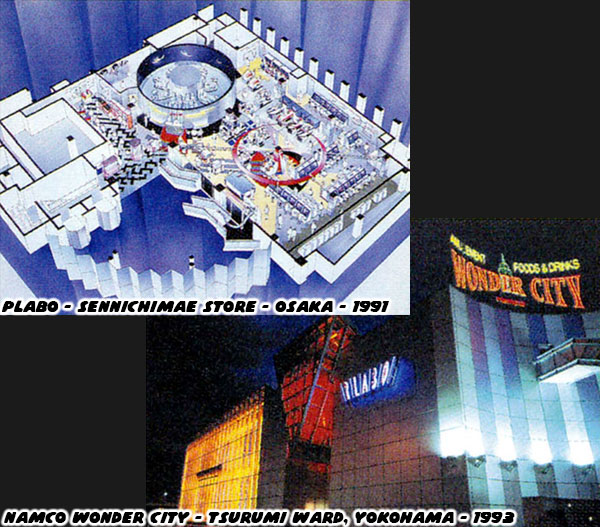
It would be a fair to say that the Namco brand was as important to the hearts, and minds of several generations in Japan as the Disney name was in the USA. In order for that comparison to be valid then we have to take a look at the leader of the company. Walt Disney had few, if any peers in his era. How would Masaya Nakamura hold up in comparison? You might be surprised. We will look at this on the next blog. As always if you would like to sponsor me
please visit my Patreon page and consider donating each month, even as little as $1 would help make better blogs and even podcasts!
Wonder Eggs, and Egg Empire research collected from: Wonder Eggs Guide Map, Namco Graffiti magazine, the book “All About Namco II", NOURS magazine, The Namco Museum, Namco Wiki, Ge-Yume Area 51 Shigeki Toyama Collection, mcSister magazine, first person attraction details from Yoshiki. Event details from Hole in the Socks




















No comments:
Post a Comment